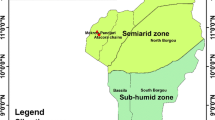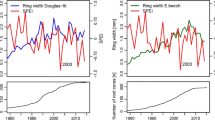Abstract
The establishment of native trees in exotic forest plantations can improve economic and ecological outcomes, and functional traits can help understanding differential responses of growth rates to stand variables. It is well known that growth rates can depend on functional traits and that the associations between functional traits and plant growth vary across ontogenetic stages. Here we studied if the response of growth rate to stand variables, that reflect ecological conditions, is associated with wood density, seed mass and height at maturity and if such relationships differ between saplings and seedlings. We measured the stem diameter increment over two years in 164 seedlings and 290 saplings of 30 tree species in 9 loblolly pine plantations in the Atlantic Forest, Argentina. The relationship between stem diameter increment and stand basal area, mean canopy openness and stand age was evaluated. The growth rate of saplings decreased with basal area and increased with canopy openness in species with wood density < 0.56 g.cm-3 or height at maturity > 23 m. No differences in growth rate response were found along seed mass. No consistent relationships between growth rate and stand variables were found in seedlings. We concluded that seedling growth rate is unrelated to stand variables while responsive species at sapling stage are those with low wood density or medium-high height at maturity. Silvicultural treatments reducing basal area can benefit the planted trees as well as unplanted saplings of medium-high valued native trees.



Similar content being viewed by others
References
Adler PB, Salguero–Gómez R, Compagnoni A, Hsu JS, Ray-Mukherjee J, Mbeau-Ache C, Franco M (2014) Functional traits explain variation in plant life history strategies. PNAS 111(2):740–745. https://doi.org/10.1073/pnas.1315179111
Bragg DC (2003) Optimal Tree Increment Models for the Northeastern United States. In: Proceedings of the fifth annual forest inventory and analysis symposium. New Orleans, LA. Gen. Tech. Rep. WO-69. Washington, DC: U.S. Department of Agriculture Forest Service, 222 p
Brockerhoff EG, Jactel H, Parrotta JA, Quine CP, Sayer J (2008) Plantation forests and biodiversity: oxymoron or opportunity? Biodivers Conserv 17:925–951. https://doi.org/10.1007/s10531-008-9380-x
Cabrera AL (1976) Regiones Fitogeográficas Argentinas. Enciclopedia Argentina de Agricultura y Jardinería, Tomo II, Fascículo 1, Acme. Buenos Aires, Argentina, p 85
Campanello PI, Gatti MG, Montti L, Villagra M, Goldstein G (2011) Ser o no ser tolerante a la sombra: economía de agua y carbono en especies arbóreas del Bosque Atlántico (Misiones, Argentina). Ecol Austral 21:285–285
Falster DS, Duursma RA, Fitz JRG (2018) How functional traits influence plant growth and shade tolerance across the life cycle. PNAS 115(29):E6789–E6798. https://doi.org/10.1073/pnas.1714044115
Gibert A, Gray EF, Westoby M, Wright IJ, Falster DS (2016) On the link between functional traits and growth rate: Meta-analysis shows effects change with plant size, as predicted. J Ecol 104:1488–1503. https://doi.org/10.1111/1365-2745.12594
Guo Q, Chi X, Xie Z, Tang Z (2017) Asymmetric competition for light varies across functional groups. J Plant Ecol 10(1):74–80. https://doi.org/10.1093/jpe/rtw114
Hérault B, Bachelot B, Poorter L, Rossi V, Bongers F, Chave J, Paine CET, Wagner F, Baraloto C (2011) Functional traits shape ontogenetic growth trajectories of rain forest tree species. J Ecol 99:1431–1440. https://doi.org/10.1111/j.1365-2745.2011.01883.x
Keenan R, Lamb D, Woldring O, Irvine T, Jensen R (1997) Restoration of plant biodiversity beneath tropical tree plantations in Northern Australia. For Ecol Manage 99:117–131. https://doi.org/10.1016/S0378-1127(97)00198-9
Lesko J, Jacobs D (2018) Conversion of conifer plantations to native hardwoods: influences of overstory and fertilization on artificial regeneration. New For 49(4):829–849. https://doi.org/10.1007/s11056-018-9683-z
Lida Y, Kohyama TS, Swenson NG, Su SH, Chen CT, Chiang JM, Sun IF (2014) Linking functional traits and demographic rates in a subtropical tree community: the importance of size dependency. J Ecol 102:641–650
Ligier HD (2000) Caracterización geomorfológica y edáfica de la provincia de Misiones, Informe para Fundación Vida Silvestre Argentina. Instituto Nacional de Tecnología Agropecuaria (INTA), Corrientes
Lindenmayer DB, Hobbs R, Salt D (2003) Plantation forests and biodiversity conservation. Aust For 66:62–66. https://doi.org/10.1080/00049158.2003.10674891
Lindenmayer DB (2019) Integrating forest biodiversity conservation and restoration ecology principles to recover natural forest ecosystems. New For 50(3):169–181. https://doi.org/10.1007/s11056-018-9633-9
Lugo AE, Zimmerman JK (2002) Ecological Life Histories. In: Vozzo JA (ed) Tropical seed manual. Agricultural Handbook 721. USDA Forest Service Washington DC
Montgomery RA, Chazdon RL (2002) Light gradient partitioning by tropical tree seedlings in the absence of canopy gaps. Oecologia 131:165–174. https://doi.org/10.1007/s00442-002-0872-1
Magnoux A, Cogliastro A, Paquette A (2018) Growth of planted seedlings inside protective sleeves under strip openings of different widths in a post-agricultural forest. New For 49(2):279–296. https://doi.org/10.1007/s11056-017-9619-z
Medina M, Ritter L, Campanello P, Arturi MF (2019) Relación entre estrategias de historia de vida y atributos funcionales en especies arbóreas del Bosque Atlántico. semideciduo de Misiones Ecología Austral 29(3):380–390. https://doi.org/10.25260/EA.19.29.3.0.827
Medina M, Pérez Flores M, Goya JF, Campanello PI, Pinazo MA, Ritter LJ, Arturi MF (2020) Native tree regeneration in native tree plantations: understanding the contribution of Araucaria angustifolia to biodiversity conservation in the threatened Atlantic Forest in Argentina. Austral Ecol 45(2):229–239. https://doi.org/10.1111/aec.12850
Muggeo V (2008) Segmented: An R Package to Fit Regression Models with Broken-Line Relationships. R News 8:20–25
Nagai M, Yoshida T (2006) Variation in understory structure and plant species diversity influenced by silvicultural treatments among 21- to 26-year-old Picea glehnii plantations. J For Res 11:1–10. https://doi.org/10.1007/s10310-005-0176-5
Pastur GM, Lencinas MV, Cellini JM, Mundo I (2007) Diameter growth: can live trees decrease? Forestry: An International Journal of Forest Research 80(1):83–88. https://doi.org/10.1093/forestry/cpl047
Placci LG, Di Bitetti MS (2006) Situación ambiental en la Ecorregión del Bosque Atlántico del Alto Paraná (Selva Paranaense). En: La Situación Ambiental Argentina. Brown A, Martinez Ortiz U, Acerbi M, Corcuera J (Eds.) Fundación Vida Silvestre Argentina. Buenos Aires
Reich PB, Wright IJ, Cavender-Bares J, Craine JM, Oleksyn J, Westoby M, Walters MB (2003) The evolution of plant functionalvariation: traits, spectra, and strategies. Int J Plant Sci 164:S143–S164. https://doi.org/10.1086/374368
Reich PB (2014) The world-wide ‘fast–slow’ plant economics spectrum: a traits manifesto. J Ecol 102:275–301. https://doi.org/10.1111/1365-2745.12211
Ritter LJ, Campanello PI, Goya JF, Pinazo MA, Arturi MF (2018) Plant size dependent response of native tree regeneration to landscape and stand variables in loblolly pine plantations in the Atlantic Forest, Argentina. For Ecol Manage 429:457–466. https://doi.org/10.1016/j.foreco.2018.07.036
Rüger N, Wirth C, Wright SJ, Condit R (2012) Functional traits explain light and size response of growth rates in tropical tree species. Ecology 93:2626–2636
Rüger N, Comita LS, Condit R, Purves D, Rosenbaum B, Visser MD, Wright SJ, Wirth C (2018) Beyond the fast-slow continuum: demographic dimensions structuring a tropical tree community. Ecol Lett 21:1075–1084. https://doi.org/10.1890/12-0622.1
Soil Survey Staff (1992) Keys to Soil Taxonomy, fifth ed. SMSS Technical Monographno 19, Pocahontas Press Inc, Blacksburg, VA, USA. 541p
Selwyn MA, Ganesan R (2009) Evaluating the potential role of Eucalyptus plantations in the regeneration of native trees in southern Western Ghats, India. Trop Ecol 50:173–189
Swaine MD, Whitmore TC (1988) On the definition of ecological species groups in tropical rain forests. Vegetatio 75:81–86. https://doi.org/10.1007/BF00044629
Trentini CP, Campanello PI, Villagra M, Ritter L, Ares A, Goldstein G (2017) Thinning of loblolly pine plantations in subtropical Argentina: impact on microclimate and understory vegetation. For Ecol Manage 384:236–247. https://doi.org/10.1016/j.foreco.2016.10.040
Vespa NI, Zurita GA, Gatti MG, Bellocq MI (2018) Seed movement between the native forest and monoculture tree plantations in the southern Atlantic forest: A functional approach. For Ecol Manage 430:126–133. https://doi.org/10.1016/j.foreco.2018.07.051
West B, Welch K, Galecki AT (2015) Linear Mixed Models A Practical Guide Using Statistical Software, Second Edition. Chapman &Hall, New York
Wright IJ, Reich PB, Westoby M, Ackerly DD, Baruch Z, Bongers F, Cavender-Bares J, Chapin T, Cornelissen JHC, Diemer M, Flexas J, Garnier E, Groom PK, Gulias J, Hikosaka K, Lamont BB, Lee T, Lee W, Lusk C, Midgley CLJJ, Navas ML, Niinemets Ü, Oleksyn J, Osada N, Poorter H, Poot P, Prior L, Pyankov VI, Roumet C, Thomas SC, Tjoelker MG, Veneklaas EJ, Villar R (2004) The worldwide leaf economics spectrum. Nature 428:821–827. https://doi.org/10.1038/nature02403
Wright SJ, Kitajima K, Kraft NJB, Reich PB, Wright IJ, Bunker DE, Condit R, Dalling JW, Davies SJ, Díaz S, Engelbrecht BMJ, Harms KE, Hubbell SP, Marks CO, Ruiz-Jaen MC, Salvador CM (2010) Functional traits and the growth-mortality trade”off in tropical trees. Ecology 12:3664–3674. https://doi.org/10.1890/09-2335.1
Zhang C, Cheng Y, He H, Gao L, Liang J, Zhao X (2017) Structural drivers of biomass dynamics in two temperate forests in China. Ecosphere 8(3):e01752. https://doi.org/10.1002/ecs2.1752
Acknowledgements
This study was funded by UCAR, National Ministry of Agriculture, Livestock and Fisheries (Argentina), the National University of La Plata (Argentina), National Scientific and Technical Research Council (CONICET, Argentina), National Institute of Agricultural Technology (INTA, Argentina) and the National University of Misiones (Argentina). We thank all the people who helped in field measurements.
Author information
Authors and Affiliations
Corresponding author
Additional information
Publisher’s note
Springer Nature remains neutral with regard to jurisdictional claims in published maps and institutional affiliations.
Rights and permissions
About this article
Cite this article
Ritter, L.J., Medina, M., Goya, J.F. et al. Functional traits and growth rate response to stand variables: differences between saplings and seedlings of native trees established in loblolly pine plantations in the Atlantic Forest. New Forests 54, 311–324 (2023). https://doi.org/10.1007/s11056-022-09923-z
Received:
Accepted:
Published:
Issue Date:
DOI: https://doi.org/10.1007/s11056-022-09923-z




